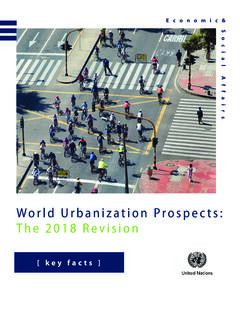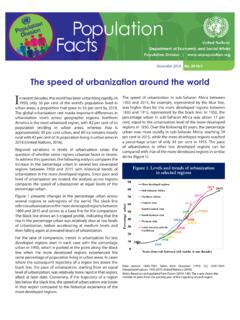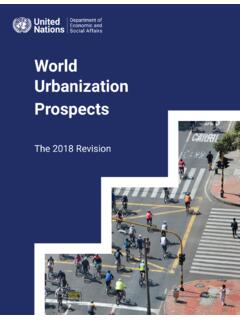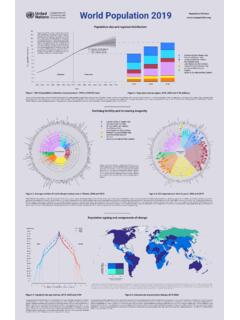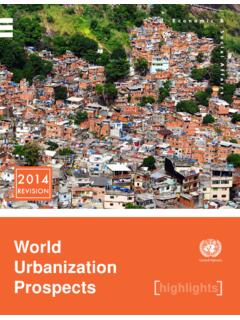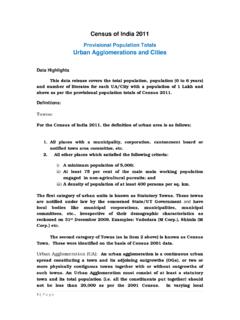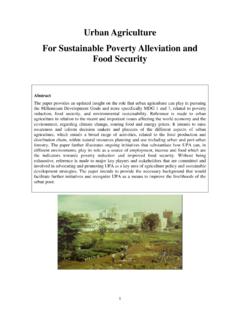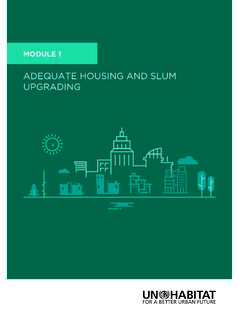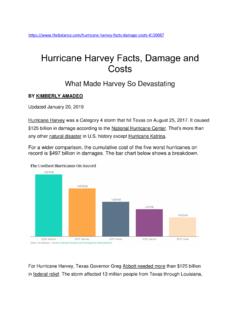Transcription of World Urbanization Prospects 2018 - Un
1 WorldUrbanizationProspects2018 HighlightsST/ of Economic and Social AffairsPopulation DivisionWorld Urbanization Prospects 2018 Highlights United Nations New York, 2019 The Department of Economic and Social Affairs of the United Nations Secretariat is a vital interface between global policies in the economic, social and environmental spheres and national action. The Department works in three main interlinked areas: (i) it compiles, generates and analyses a wide range of economic, social and environmental data and information on which States Members of the United Nations draw to review common problems and take stock of policy options; (ii) it facilitates the negotiations of Member States in many intergovernmental bodies on joint courses of action to address ongoing or emerging global challenges; and (iii) it advises interested Governments on the ways and means of translating policy frameworks developed in United Nations conferences and summits into programmes at the country level and, through technical assistance, helps build national Population Division of the Department of Economic and Social Affairs provides the international community with timely and accessible population data and analysis of population trends and development outcomes for all countries and areas of the World .
2 To this end, the Division undertakes regular studies of population size and characteristics and of all three components of population change (fertility, mortality and migration). Founded in 1946, the Population Division provides substantive support on population and development issues to the United Nations General Assembly, the Economic and Social Council and the Commission on Population and Development. It also leads or participates in various interagency coordination mechanisms of the United Nations system. The work of the Division also contributes to strengthening the capacity of Member States to monitor population trends and to address current and emerging population designations employed in this report and the material presented in it do not imply the expression of any opinions whatsoever on the part of the Secretariat of the United Nations concerning the legal status of any country, territory, city or area or of its authorities, or concerning the delimitation of its frontiers or term country as used in this report also refers, as appropriate, to territories or areas.
3 This report is available in electronic format on the Division s website at For further information about this report, please contact the Population Division, Department of Economic and Social Affairs, United Nations, Two United Nations Plaza, DC2-1950, New York, 10017, USA; phone: +1 212-963-3209; email: citation:United Nations, Department of Economic and Social Affairs, Population Division (2019). World Urbanization Prospects 2018: Highlights (ST/ ). Official symbols of United Nations documents are composed of capital letters combined with numbers, as illustrated in the above cover photo credit: Bicyclist ride the streets of Bogot , Colombia, by Dominic Chavez/ World Bank, 2016, used under CC BY-NC-ND cover photo credit: Ma Tso Lung - Shenzhen View by ystsoi, 2019, ( @N03/47716332192/), used under CC BY by the United NationsSales no.: : 978-92-1-148318-5eISBN: 978-92-1-004313-7 Copyright 2019 by United Nations, made available under a Creative Commons license (CC BY IGO) Urbanization Prospects 2018: HighlightsiiiUnited Nations, Department of Economic and Social Afiairs, Population DivisionWhat Is Urbanization ?
4 Urbanization is a complex socio-economic process that transforms the built environment, converting formerly rural into urban settlements, while also shifting the spatial distribution of a population from rural to urban areas. It includes changes in dominant occupations, lifestyle, culture and behaviour, and thus alters the demographic and social structure of both urban and rural areas. A major consequence of Urbanization is a rise in the number, land area and population size of urban settlements and in the number and share of urban residents compared to rural is shaped by spatial and urban planning as well as by public and private investments in buildings and infrastructure. An increasing share of economic activity and innovation becomes concentrated in cities , and cities develop as hubs for the flow of transport, trade and information. cities also become places where public and private services of the highest quality are available and where basic services are often more accessible than in rural areas.
5 The degree or level of Urbanization is typically expressed as the percentage of population residing in urban areas, defined according to criteria used by national governments for distinguishing between urban and rural areas (see box 3 for the definitions used in this report). In practice, Urbanization refers both to the increase in the percentage of population residing in urban areas and to the associated growth in the number of urban dwellers, in the size of cities and in the total area occupied by urban settlements. ContentsWhat Is Urbanization ? .. iiiWorld Urbanization Prospects 2018: Key Facts .. 1 Introduction and Policy Implications .. 3 Trends in Urbanization .. 5 cities .. 15 References .. 19 Annex Tables .. 21 World Urbanization Prospects 2018: Highlights1 United Nations, Department of Economic and Social Afiairs, Population Division Urban growth is closely related to the three dimensions of sustainable development: social, economic, and environmental.
6 Well-managed Urbanization , informed by an understanding of population trends over the long run, can help to maximize the benefits of high levels of density while minimizing environmental degradation and other potential adverse impacts of a growing number of city dwellers. To ensure that the benefits of Urbanization are shared and that no one is left behind, policies to manage urban growth need to ensure access to infrastructure and social services for all, focusing on the needs of the urban poor and other vulnerable groups for housing, education, health care, decent work and a safe environment. Globally, more people live in urban areas than in rural areas, with 55 per cent of the World s population residing in urban areas in 2018. In 1950, 30 per cent of the World s population was urban, and by 2050, 68 per cent of the World s population is projected to be urban.
7 Today, the most urbanized regions include Northern America (with 82 per cent of its population living in urban areas in 2018), Latin America and the Caribbean (81 per cent), Europe (74 per cent) and Oceania (68 per cent). The level of Urbanization in Asia is now approximating 50 per cent. Meanwhile, Africa remains mostly rural, with 43 per cent of its population living in urban areas. The rural population of the World has grown slowly since 1950 and is expected to reach its peak in a few years. The global rural population is now close to billion and is expected to rise slightly and then decline to around billion in 2050. Africa and Asia are home to nearly 90 per cent of the World s rural population. India has the largest rural population (893 million), followed by China (578 million). The urban population of the World has grown rapidly since 1950, having increased from 751 million to billion in 2018.
8 Asia, despite being less urbanized than most other regions today, is home to 54 per cent of the World s urban population, followed by Europe and Africa (13 per cent each). Growth in the urban population is driven by an overall population increase and by the upward shift in the percentage living in urban areas. Together, these two factors are projected to add billion to the World s urban population by 2050, with almost 90 per cent of this growth happening in Asia and Africa. Just three countries India, China and Nigeria are expected to account for 35 per cent of the growth in the World s urban population between 2018 and 2050. India is projected to add 416 million urban dwellers, China 255 million and Nigeria 189 million. Close to half of the World s urban dwellers reside in settlements with fewer than 500,000 inhabitants, while around one in eight live in 33 megacities with more than 10 million inhabitants.
9 By 2030, the World is projected to have 43 megacities, most of them in developing regions. Tokyo is the World s largest city with an agglomeration of 37 million inhabitants, followed by Delhi with 29 million, Shanghai with 26 million, and Mexico City and S o Paulo, each with around 22 million inhabitants. Cairo, Mumbai, Beijing and Dhaka all have close to 20 million inhabitants. Some cities have experienced population decline in recent years. Most of these are located in the low-fertility countries of Asia and Europe where overall population sizes are stagnant or declining. Also, economic contraction and natural disasters have contributed to population losses in some cities . As the World continues to urbanize, sustainable development depends increasingly on the successful management of urban growth, especially in low-income and lower-middle-income countries where the most rapid Urbanization is expected between now and 2050.
10 Integrated policies to improve the lives of both urban and rural dwellers are needed, strengthening the linkages between urban and rural areas and building on their existing economic, social and environmental Urbanization Prospects 2018: Key FactsWorld Urbanization Prospects 2018: Highlights2 United Nations, Department of Economic and Social Afiairs, Population DivisionBox 1. Data and methods* In preparing estimates and projections of the urban population, the United Nations mostly relies on data from national sources, including data reported to the UN Demographic Yearbook, reflecting varying definitions and criteria established by national authorities both for the level of Urbanization , expressed as the percentage urban, and for the population size of cities . United Nations estimates and projections of the urban population of a country are based on officially reported trends of the proportion of the population living in urban areas.


